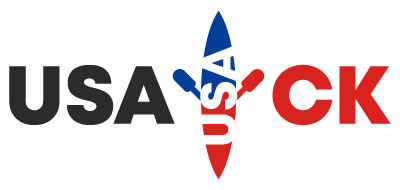Glossary
“2” – A two-second penalty assessed against whitewater paddlers who touch one or both of the gate poles while attempting to pass through the gate.
“50” – A 50 second penalty assessed against whitewater paddlers if the paddler fails to pass through the gate, passes through the gate while underwater or in the wrong direction (i.e. moving through an upstream gate in a downstream direction) or intentionally moves a gate pole to permit movement through the gate.
Beam – The widest part of the canoe.
Bent-Shaft Paddle – Any canoe or kayak paddle with a bend in the shaft, usually at the paddlers throat area. Effect is exponential increase in power varying compromise in control, depending on degree of bend.
Blade – The wide part of the paddle that goes in the water.
Bow – The front end of the boat.
Broach – Occurs when a canoe or kayak becomes caught in the current against an obstruction and turns sideways. Considered very dangerous.
C-1 – One-person canoe. The paddler kneels in the boat and uses a single-bladed paddle.
C-2 – Two-person canoe. The paddler kneels in the boat and uses a single-bladed paddle.
Canoe – An open craft with pointed ends that is propelled with a single-bladed paddle. Also called an “open boat.”
Chute – Area where a river’s flow is suddenly constricted, compressing and amplifying the current’s energy into a narrow tongue of water.
Class I-VI – International standard classification system for rating the difficulty of fast-moving water.
Deck – Closed in area over the top of a canoe or kayak.
Downstream Gate – A slalom gate which is negotiated in the same direction as the flow of the river. Distinguished by its green and white stripes.
Draw – A stroke pulling in toward the paddler at 90 degrees to the direction of travel. When executed by the bowman of a two-man canoe, it will turn in the boat in the direction of the drawing side.
Eddy – A pool of more calm water which is out of the main current of a stream. Located behind obstacles in the river or near the shore, eddies are likely locations for upstream gates, since the paddlers would not have to battle the full force of the current to move through the an upstream gate.
Eskimo Roll – A maneuver performed by a paddler whose boat has rolled or tipped over. By using the paddle as a brace against the water, the paddler can right himself or herself and continue compelling.
Fast and Clean – The goal of a whitewater paddler. Fast (cover the course as quick as possible) and clean (no penalty points).
Flatwater – Lake water or a slow-moving river current with no rapids. Also a shorthand term to refer to the Olympic discipline of flatwater sprint racing.
Grip – The end of a canoe paddle opposite from the blade; should be shaped to fit comfortably into the paddler’s hand.
Gunwale – (Pronounced “gunnel”) The upper edge of the boat’s side. Inside strips are “inwales;” outside strips are “outwales.”
Hull – The body of a canoe or kayak; the area that has the greatest impact on how the boat and water interact. A flatwater sprint boats V-shaped hull gives it better tracking, while a whitewater slalom boat’s rounded hull makes it more maneuverable.
“J” Stroke – A stroke that ends in a rudder, usually used by sprint canoeists to maintain a straight-line course.
K-1 – One-person kayak. For women’s classes, a “W” is added (K-1W).
K-2 – Two-person kayak. For women’s classes, a “W” is added (K-1W).
K-4 – Four-person kayak. For women’s classes, a “W” is added (K-1W).
Kayak – Self-propelled watercraft is which a paddle is enclosed and uses a double-bladed paddle from a sitting position.
Keel – The ridge running the length of the boat’s bottom which prevents sideslipping in the wind or in a lake. Also adds rigidity or structural support to the hull.
Line – The path a whitewater paddler chooses to take through the gates.
Paddle – Primary tool for propelling canoes and kayaks.
Rapids – Section of a river where the currents speed up and flows turbulently over and around boulders, drop-offs, ledges, etc. Also known as whitewater.
River Left – The left side of the river as it would appear to a paddler facing downstream.
River Right – The right side of the river as it would appear to a paddler facing downstream.
Rudder – Dragging the paddle to create resistance; when executed by the sternsman of a two-man canoe, the boats turns in the direction of the rudder side.
Shaft – The narrow part of the paddle which the paddler grips.
Stern – The back end of the boat.
Sweep – A stroke made in a broad curve. Turns the boat in the direction opposite the sweeping side.
Thwart – The supporting member extending across the canoe between the gunwales.
Upstream Gate – A slalom gate which must me negotiated against the flow of the river. Distinguished with red and white stripes.
Whitewater – Turbulent, heavily aerated water caused by its flowing around or over obstacles in the current. Also a shorthand term to refer to the Olympic discipline of whitewater slalom racing.
